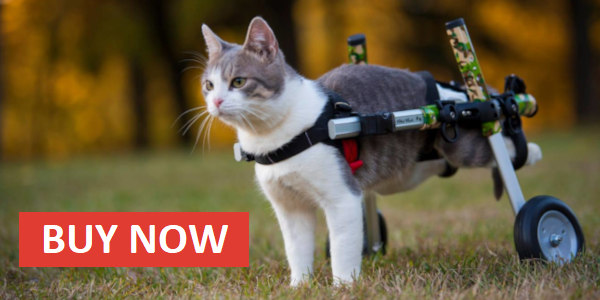Cat Mobility Loss: Causes & Solutions
By admin / March 19, 2023 / No Comments / Uncategorized
As cats age they may slow down or have difficulty walking, and any change to their mobility can affect their physical and mental health. Cats need the freedom to explore the world around them, both inside the house and outside. Here are some simple things every cat parent should know about helping their cat stay active.
Symptoms of Feline Mobility Issues
If you’re worried that your cat is in pain or experiencing mobility problems, watch for key changes in their behavior and lifestyle. There are many factors that can contribute to these changes so, it’s important to work closely with your Veterinarian if your cat is beginning to exhibit any of the following signs.
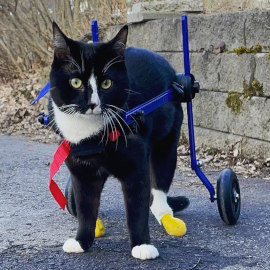
- Changes in grooming patterns
- Sleeping more often
- Increased aggression: biting & scratching when touched
- Shallow breathing
- Decreased energy level
- Weak back legs
- Limping or change in gait
- Difficulty with or slowing on stairs
- Dilated pupils
- Arched spine
- Less eager to jump or inability to reach higher surfaces
A cat will mask their pain, so the normal symptoms you’d see in a dog are not the same signs of pain that a cat will show. Signs of mobility loss in cats can vary, your best course of action is to be on the lookout for behavioral changes.
Causes of Cat Mobility Loss or Cat Paralysis
Paralysis in cats is often an indication of an underlying health condition. A cat’s mobility can be partially affected, temporary, or permanent if left untreated. A cat’s paralysis may mean they cannot move their legs or lose mobility in a specific body part like the tail or neck. Just because your cat is dragging their back legs, it doesn’t not mean they’re in pain. Their are many cases where cats drag their back legs and feel no pain, it just depends on the underlying condition that causes the paralysis. Here are feline health conditions that may impact how your cat moves:
Arthritis in Cats
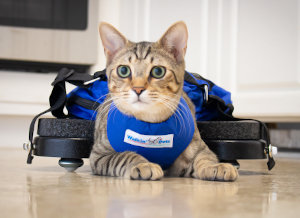
Arthritis is by far the most common condition effecting cats, but with it’s slow onset the signs can be easily missed. 30% of cats over the age of 8 deal with arthritis pain and that number increases dramatically in cats over the age of 12 to 90% of the feline population.
Degenerative Joint Disease (DJD) and osteoarthritis occurs when the cartilage in your cat’s joints weakens and breaks down. This joint deterioration leads to painful joint inflammation.
Feline Diabetes
Just like in humans, senior and overweight cats can be prone to diabetes. If left untreated diabetes can lead to difficulty walking and standing due to diabetic nerve damage. Along with mobility issues, diabetic cats are at a high risk for developing vision problems and going blind.
Saddle Thrombus
Saddle thrombus occurs when a cat has decreased blood flow to the legs caused when a blood clot dislodges and is trapped in the pelvic end of the aorta. Most commonly occurring in cats with heart disease, the symptoms can be treated by your Vet by dissolving the clot and managing your cat’s pain. Once treated your cat’s mobility should return to normal.
Dr. Justin Padgett DVM, an associated veterinarian at Branchville Animal Hospital and Kitty Cat Tips, saddle thrombus is an especially difficult diagnosis, “Saddle thrombus (aortic thromboembolism) cases are heartbreaking. They are not rewarding to treat and a majority of these cats are euthanized due to pain and discomfort as well as the paralysis that is caused. They also have a high rate of recurrence if they are successfully treated.”
Traumatic Injury
A traumatic injury such as a bad fall or being hit by a car is a common cause of paralysis in cats. Trauma can leave a cat with broken legs, a broken pelvis, or serious spinal injury any of which can cause a cat to become paralyzed.
Kidney Disease in Cats
Cats with advanced kidney disease can experience weakness in their hind legs. Most often the back legs appear wobbly or buckle unexpectedly underneath your cat.
Neurological and Spinal Conditions
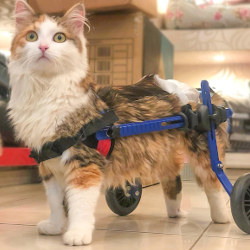
Back injuries, including slipped discs, and neurological conditions are not uncommon in cats and can occur at any age. Spinal injuries can be especially dangerous in cats because some felines will try to mask the problem.
Other spinal conditions can occur from infection, inflammation of the nerves or muscle, or even cancer.
Consult your Vet immediately if your cat begins dragging a leg, is unable to move their legs or appears unable to stand.
Additional feline mobility conditions include: cerebellar hypoplasia, IVDD, paralysis, and mobility loss due to trauma or injury.
Mobility Loss Solutions for Cats
Supporting your cat’s mobility and keeping them active is vital to a cat’s quality of life.
Cat Wheelchairs
Just like dogs, cats can experience sudden paralysis or rear leg weakness and a cat wheelchair is the perfect mobility solution. Cat wheelchairs allow disabled and paralyzed cats to run, play and allow them to get the exercise they need. A feline wheelchair supports your cat so the can stand, walk, and run so they can regain their independence.
Additional benefits of a cat wheelchair include:
- Improved mental health
- Helps cats rebuild their strength
- Rehabilitative support post injury or surgery
- Prevents muscle atrophy
- More exercise means improved bodily function
A disabled cat can greatly benefit from the assistive support of a mobility cart.
There are two types of cat wheelchairs: rear support wheelchair and full support wheelchair. Here’s how you chose the right wheelchair for your cat:
Rear Wheelchair for Cats
A rear wheelchair is perfect for cats with weak or paralyzed back legs. The wheelchair supports their hind end allowing your cat to continue to get around with ease. A cat wheelchair will help a disabled cat to stand and walk during rehabilitation. Not only does a wheelchair make it easier for a cat to move, it can also encourage feline mobility.
Full Support Cat Wheelchair
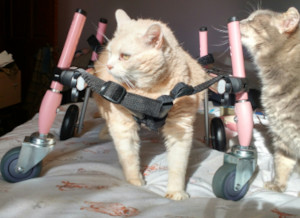
For cats needing support in both their front and back legs, the quad wheelchair is ideal. With both front and back wheels your cat is fully supported. A four wheel cart helps cats maintain their balance and remain supported as they exercise.
Even some cats who are disabled in only the rear legs will do better with a 4-wheel wheelchair. With their whole body supported some cats are more comfortable. The added support of the front wheels makes it easier to move and allows them to move more naturally.
Improving Cat Mobility with a Wheelchair
According to Dr. Padgett, “Paralyzed cats can learn to get around with assistance in an indoor, open area just as well as dogs can. I have had cats with intervertebral disc disease (IVDD) that have become paralyzed that likely would have done well with a wheelchair. An owner of a paralyzed cat that is considering a mobility and has to be 100% committed and be able to spend a large amount of time with the animal. The animal will likely need assistance urinating and defecating, will need to be cleaned often, and will need to be watched to be sure they don’t end up getting stuck somewhere they can’t escape.”
Cat Wheelchair Accessories
Drag Bag – the drag bag is perfect for indoor cats to wear when they’re not using the Walkin’ Wheels. Protects their legs and chest from injuries caused by scrapping.
Front Vest – the Walkin’ Front Vest is a great alternative to the standard wheelchair harness, perfect for escape artist cats who can wiggle out of most harnesses.
Belly Support – this neoprene belly support wraps around the side bars of the wheelchair and supports the center of your cat’s body. Great for cats with spinal disease or weak backs.
Most importantly, be patient with your cat. Some cats need a little more time to adjust to using a wheelchair. Once they get used to it and realize that the wheelchair is helping them to explore the world around them, they’ll never want to take it off!
